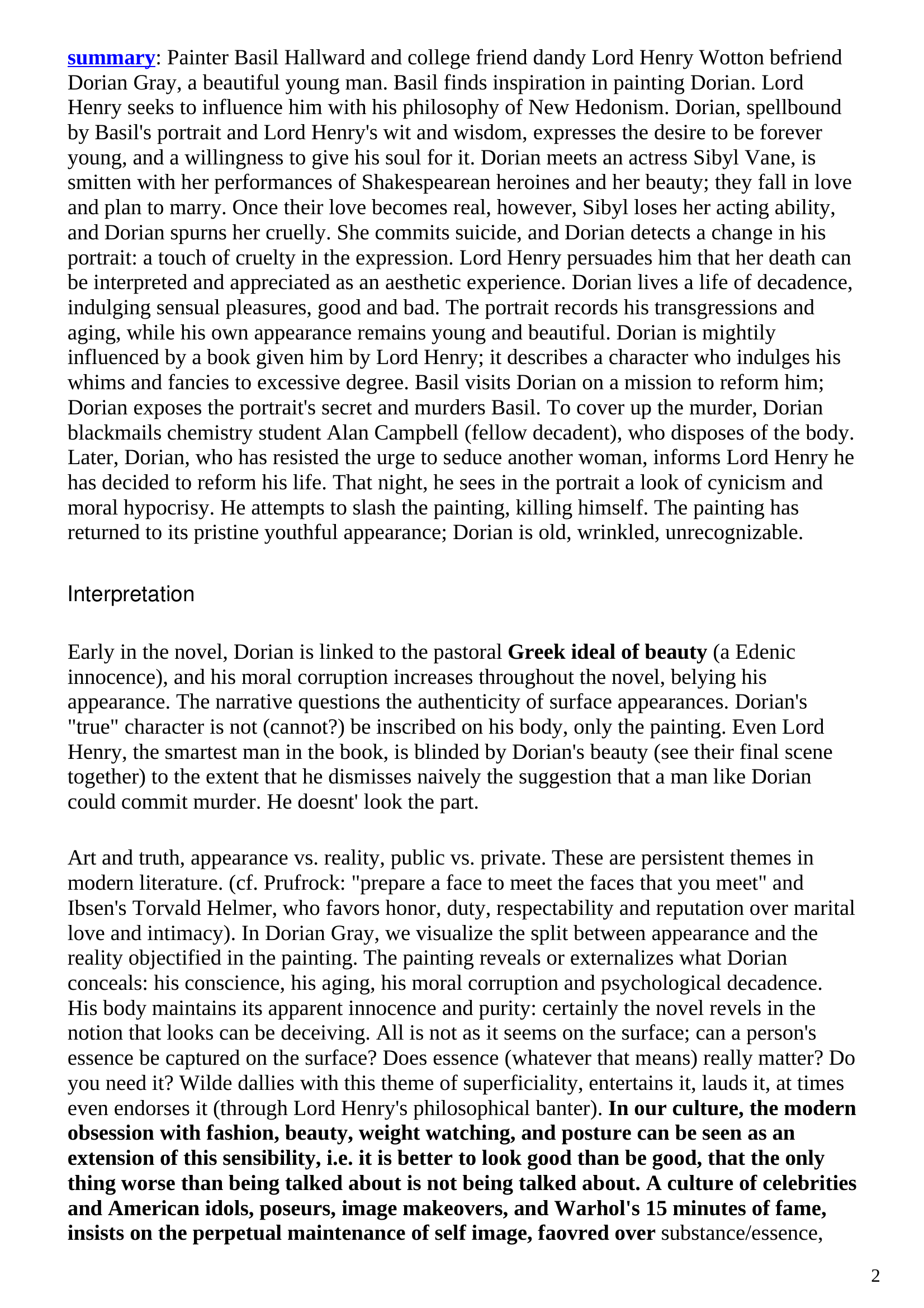the legend of dorian gray
Publié le 06/11/2012

Extrait du document
«
summary : Painter Basil Hallward and college friend dandy Lord Henry Wotton befriend
Dorian Gray, a beautiful young man.
Basil finds inspiration in painting Dorian.
Lord
Henry seeks to influence him with his philosophy of New Hedonism.
Dorian, spellbound
by Basil's portrait and Lord Henry's wit and wisdom, expresses the desire to be forever
young, and a willingness to give his soul for it.
Dorian meets an actress Sibyl Vane, is
smitten with her performances of Shakespearean heroines and her beauty; they fall in love
and plan to marry.
Once their love becomes real, however, Sibyl loses her acting ability,
and Dorian spurns her cruelly.
She commits suicide, and Dorian detects a change in his
portrait: a touch of cruelty in the expression.
Lord Henry persuades him that her death can
be interpreted and appreciated as an aesthetic experience.
Dorian lives a life of decadence,
indulging sensual pleasures, good and bad.
The portrait records his transgressions and
aging, while his own appearance remains young and beautiful.
Dorian is mightily
influenced by a book given him by Lord Henry; it describes a character who indulges his
whims and fancies to excessive degree.
Basil visits Dorian on a mission to reform him;
Dorian exposes the portrait's secret and murders Basil.
To cover up the murder, Dorian
blackmails chemistry student Alan Campbell (fellow decadent), who disposes of the body.
Later, Dorian, who has resisted the urge to seduce another woman, informs Lord Henry he
has decided to reform his life.
That night, he sees in the portrait a look of cynicism and
moral hypocrisy.
He attempts to slash the painting, killing himself.
The painting has
returned to its pristine youthful appearance; Dorian is old, wrinkled, unrecognizable.
Interpretation
Early in the novel, Dorian is linked to the pastoral Greek ideal of beauty (a Edenic
innocence), and his moral corruption increases throughout the novel, belying his
appearance.
The narrative questions the authenticity of surface appearances.
Dorian's
"true" character is not (cannot?) be inscribed on his body, only the painting.
Even Lord
Henry, the smartest man in the book, is blinded by Dorian's beauty (see their final scene
together) to the extent that he dismisses naively the suggestion that a man like Dorian
could commit murder.
He doesnt' look the part.
Art and truth, appearance vs.
reality, public vs.
private.
These are persistent themes in
modern literature.
(cf.
Prufrock: "prepare a face to meet the faces that you meet" and
Ibsen's Torvald Helmer, who favors honor, duty, respectability and reputation over marital
love and intimacy).
In Dorian Gray, we visualize the split between appearance and the
reality objectified in the painting.
The painting reveals or externalizes what Dorian
conceals: his conscience, his aging, his moral corruption and psychological decadence.
His body maintains its apparent innocence and purity: certainly the novel revels in the
notion that looks can be deceiving.
All is not as it seems on the surface; can a person's
essence be captured on the surface? Does essence (whatever that means) really matter? Do
you need it? Wilde dallies with this theme of superficiality, entertains it, lauds it, at times
even endorses it (through Lord Henry's philosophical banter).
In our culture, the modern
obsession with fashion, beauty, weight watching, and posture can be seen as an
extension of this sensibility, i.e.
it is better to look good than be good, that the only
thing worse than being talked about is not being talked about.
A culture of celebrities
and American idols, poseurs, image makeovers, and Warhol's 15 minutes of fame,
insists on the perpetual maintenance of self image, faovred over substance/essence,
2.
»
↓↓↓ APERÇU DU DOCUMENT ↓↓↓
Liens utiles
- Oscar Wilde: The Picture of Dorian Gray (Sprache & Litteratur).
- fiche de lecture litterature anglaise "the picture of dorian gray"
- GRAY Dorian. Personnage du roman d’Oscar Wilde le Portrait de Dorian Gray
- PORTRAIT DE DORIAN GRAY (Le) Oscar Wilde (résumé et analyse de l’oeuvre)
- PARQUES (Les) [The Fatal Sisters] Thomas Gray

































